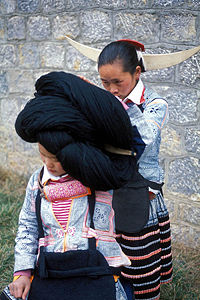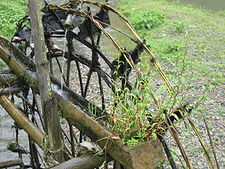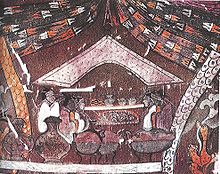- Miao people
-
Miao
Hmongb/Hmub/Xongb/ab Hmaob
m̥˭oŋ⁴³/m̥ʰu³³/ɕoŋ³⁵/a⁵³m̥˭ao⁵³
Headdress of the Long-horn Miao—one of the small branches of Miao living in the 12 villages near Zhijin County (织金县), Guizhou Province. Total population 10-12 million[citation needed] Regions with significant populations China: 9 million
Vietnam: 787,604(1999)
Laos: 460,000(2005)
France: 10,000
United States: 209,866 (2006)[1]
Thailand: 151,080(2002)
French Guiana: 3,000Languages Religion Taoism, Shamanism, Christianity, Others
The Miao (Chinese: 苗; pinyin: Miáo; Vietnamese: Mèo or H'Mông; Thai: แม้ว (Maew) or ม้ง (Mong); Burmese: mun lu-myo) is an ethnic group recognized by the government of the People's Republic of China(PRC) as one of the 55 official minority groups. Miao is a Chinese term and does not reflect the self-designations of the component nations of people, which include (with some variant spellings) Hmong, Hmu, A Hmao, and Kho (Qho) Xiong. The Chinese government has grouped these people and other non-Miao peoples together as one group, whose members may not necessarily be either linguistically or culturally related. For this reason, many Miao peoples can not communicate with each other, and have different histories and cultures. Some groups designated as Miao by the PRC do not even agree that they belong to the ethnic group.
The Miao live primarily in southern China, in the provinces of Guizhou, Hunan, Yunnan, Sichuan, Guangxi, Hainan, Guangdong, and Hubei. Some members of the Miao sub-groups, most notably Hmong people, have migrated out of China into Southeast Asia (northern Vietnam, Laos, Burma (Myanmar) and Thailand). Following the communist takeover of Laos in 1975, a large group of Hmong refugees resettled in several Western nations, such as the United States, France, Australia, and elsewhere. There has been a recent tendency by (H)mong Americans to group all Miao peoples together under the term Hmong because of their disdain for the Chinese term Miao. This however fails to recognize that, while the Hmong are a small nation within the broader linguistic/cultural family of Miao people, the vast majority of Miao people do not classify themselves as Hmong and have their own names for themselves.
Miao people Chinese 苗族 Transcriptions Hakka - Romanization Mèu-tshu̍k Min - Hokkien POJ Biâu-cho̍k - Min-dong BUC Mièu-cŭk - Teochew Peng'im Miêu-tsôk Wu - Romanization miau zoh Contents
Nomenclature: Miao and Hmong
 Miao musicians from the Langde Miao Ethnic Village, Guizhou.
Miao musicians from the Langde Miao Ethnic Village, Guizhou.
 Miao girls also from Lang De, Guizhou, awaiting their turn to perform.
Miao girls also from Lang De, Guizhou, awaiting their turn to perform.
The term "Miao" gained official status in 1949 as a minzu (nationality) encompassing a group of linguistically related ethnic minorities in southwest China. This was part of a larger effort to identify and classify minority groups to clarify their role in national government, including: establishing areas of autonomous government and allocating the seats for representatives in provincial and national government.[2]
Historically, the term "Miao" had been applied inconsistently to a variety of non-Han peoples often with the connotation of "barbarian." This former meaning has not kept members of the modern nationality from self-identifying as Miao. Outside of China, "Meo", a variation of "Miao" still exists in Southeast Asia where it is often used in a highly derogatory way. Western researchers have treated the terminological problems in a non-uniform way. Early writers used Chinese-based names in various transcriptions: Miao, Miao-tse, Miao-tsze, Meau, Meo, mo, miao-tseu etc. When referring to specific sub-groups of the Miao nationality or to ethnic groups outside of China, it is preferable to use the ethnonym of the specific group, for instance: Ka Nao, Hmu, Hmong etc. The prominence of Hmong people in the West has led to a situation where the Miao linguistic/cultural family is sometimes referred to as Hmong, despite the fact that they are only one a small sub-group contained in the classification. Following the recent increased interaction of Hmong in the West with Miao in China, it is reported that some non-Hmong Miao have even begun to identify themselves as Hmong.[3] While other Miao people's have reinforced the use of the term Miao over (H)mong, especially those with long assimilationist relationships with the Chinese.
Though the Miao themselves use various self-designations, the Chinese traditionally classified them according to the most characteristic colour of the women's clothes. The list below contains some of the self-designations, the colour designations and the main regions inhabited by the four major groups of Miao in China:
- Ghao Xong; Red Miao; west Hunan.
- Hmu, Gha Ne (Ka Nao); Black Miao; southeast Guizhou.
- A-Hmao; Big Flowery Miao; northwest Guizhou and northeast Yunnan.
- Gha-Mu, Hmong, White Miao, Mong, Green (Blue) Miao, Small Flowery Miao; south Sichuan, west Guizhou and south Yunnan.
Demographics
 Miao women during market day in Laomeng village, Yuanyang county, Yunnan province, China
Miao women during market day in Laomeng village, Yuanyang county, Yunnan province, China
According to the 2000 census, the number of Miao in China was estimated to be about 9.6 million. Outside of China, members of the Miao linguistic/cultural family sub-group or nations of the Hmong live in Thailand, Laos, Vietnam and Burma due to migrations starting in the 18th century. As a result of recent migrations in the aftermath of the Indochina and Vietnam wars between 1949 and 1975, many Hmong people now live in the United States, French Guiana, France and Australia. Altogether there are approximately 8 million speakers in the Miao language family. This language family, which consists of 6 languages and around 35 dialects (some of which are mutually intelligible) belongs to the Hmong/Miao branch of the Hmong–Mien (Miao–Yao) language family.
The Hmong primarily live in the northern mountainous reaches of Southeast Asia including Thailand, Laos and Vietnam, and in far Southwest China mostly in the provinces of Yunnan, Guangxi, and to a very limited extend in Guizhou. There are about 1.5-2 million Hmong in China.
- Note: The Miao areas of Sichuan province became part of the newly created Chongqing Municipality in 1997.
Most Miao currently live in China. Miao population growth in China:
- 1953: 2,510,000
- 1964: 2,780,000
- 1982: 5,030,000
- 1990: 7,390,000
3,600,000 Miao, about half of the entire Chinese Miao population, were in Guizhou in 1990. The Guizhou Miao and those in the following six provinces make up over 98% of all Chinese Miao:
- Hunan: 1,550,000
- Yunnan: 890,000
- Sichuan: 530,000
- Guangxi: 420,000
- Hubei: 200,000
- Hainan: 50,000 (known as Miao but ethnically Yao and Li)
In the above provinces, there are 6 Miao autonomous prefectures (shared officially with one other ethnic minority):
- Qiandongnan Miao and Tong Autonomous Prefecture (黔东南 : Qiándōngnán), Guizhou
- Qiannan Buyi and Miao Autonomous Prefecture (黔南 : Qiánnán), Guizhou
- Qianxinan Buyi abd Miao Autonomous Prefecture (黔西南 : Qiánxīnán), Guizhou
- Xiangxi Tujia and Miao Autonomous Prefecture (湘西 : Xiāngxī), Hunan
- Wenshan Zhuang and Miao Autonomous Prefecture (Hmong) (文山 : Wénshān), Yunnan
- Enshi Tujia and Miao Autonomous Prefecture (恩施 : Ēnshī), Hubei
There are in addition 23 Miao autonomous counties:
- Hunan: Mayang (麻阳 : Máyáng), Jingzhou (靖州 : Jīngzhōu), and Chengbu (城步 : Chéngbù)
- Guizhou: Songtao (松桃 : Sōngtáo), Yingjiang (印江 : Yìnjiāng), Wuchuan (务川 : Wùchuān), Daozhen (道真 : Dǎozhēn), Zhenning (镇宁 : Zhènníng), Ziyun (紫云 : Zǐyún), Guanling (关岭 : Guānlíng), and Weining (威宁 : Wēiníng)
- Yunnan: Pingbian (屏边 : Píngbiān), Jinping (金平 : Jīnpíng), and Luquan (禄劝 : Lùquàn)
- ChongQing: Xiushan (秀山 : Xiùshān), Youyang (酉阳 : Yǒuyáng), Qianjiang (黔江 : Qiánjiāng), and Pengshui (彭水 : Péngshuǐ)
- Guangxi: Rongshui (融水 : Róngshuǐ), Longsheng (龙胜 : Lóngshēng), and Longlin (隆林 : Lōnglín) (including Hmong)
- Hainan: Qiong (琼中 : Qióngzhōng) and Baoting (保亭 : Bǎotíng)
Most Miao reside in hills or on mountains, such as
- Wuling Mountain by the Qianxiang River (湘黔川边的武陵山 : Xiāngqián Chuān Biān Dí Wǔlíng Shān)
- Miao Mountain (苗岭 : Miáo Líng), Qiandongnan
- Yueliang Mountain (月亮山 : Yuèliàng Shān), Qiandongnan
- Greater and Lesser Ma Mountain (大小麻山 : Dà Xiǎo Má Shān), Qiannan
- Greater Miao Mountain (大苗山 : Dà Miáo Shān), Guangxi
- Wumeng Mountain by the Tianqian River (滇黔川边的乌蒙山 : Tiánqián Chuān Biān Dí Wūmēng Shān)
Several thousands of Miao left their homeland to move to larger cities like Guangzhou and Beijing. There are also 2,000,000 Hmong spread throughout northern Vietnam, Laos, Burma, and on other continents. 174,000 live in Thailand, where they are one of the six main hill tribes.
Young ethnic Miao boy in Guizhou, ChinaTraditional Miao Boat used to travel down rapids for trading goods.Traditional Miao irrigation system made entirely of wood planks (Yunnan Province)History
History according to Chinese legend and other considerations
According to Chinese legend, the Miao who descended from the Jiuli tribe led by Chiyou (Chinese: 蚩尤 pinyin: Chīyoú) were defeated at the Battle of Zhuolu (Chinese: 涿鹿 pinyin: Zhuōlù, a defunct prefecture on the border of present provinces of Hebei and Liaoning) by the military coalition of Huang Di (Chinese: 黃帝 pinyin: Huángdì) and Yan Di, leaders of the Huaxia (Chinese: 華夏 pinyin: Huáxià) tribe as the two tribes struggled for supremacy of the Yellow River valley. According to legend, the battle, said to have taken place in the 26th century BC, was fought under heavy fog. The Huaxia, who possessed a form of mechanical compass, was able to defeat the tribe of Chiyou. (In an alternative account, Chiyou was never defeated and has been worshiped as god. It is generally accepted that Chiyou has been worshiped by succeeding dynasties regardless of their ethnic origins. This further corroborates the possibility that the defeat was not a fact but a likely story rewritten to legitimize the Huaxia history for later Han Chinese dynasties such as Qin or Han.)
After general population movement toward south, southwest, and southeast (due in part to influx of northern and western groups such as Huaxia and Donghu), the tribe of Chiyou split into two smaller splinter tribes, the Miao and the Li (Chinese: 黎; pinyin: lí). The Miao continuously moving southwest and Li southeast as the Huaxia people, later known as Han Chinese, expanded southward. Some members of the Miao and Li tribes were assimilated into the Han Chinese during the Zhou Dynasty. (Recent DNA studies suggest that the movement of ethnic groups such as Miao in ancient East Asia is far more complex than this unsubstantiated "historical" accounts.[citation needed])
Another version of the story says that the tribe split three ways. It is said Chiyou had 3 sons, and after the fall of Jiuli, his eldest son led some people south, his middle son led some people north, and his youngest son remained in Zhuolu and assimilated into the Huaxia culture. Those who were led to the south established the San-Miao nation.
History according to Miao legend and other considerations
According to the Miao burial ritual 'Show the Way', Miao history can be traced to as early as the Shang Dynasty (1600–1046 BC). After the fall of Shang to Zhou, then came the Chu. When Chu fell to Qin, the great migration began. Many remained and started the great revolt that helped found the Han Dynasty under Liu Bang. Miao culture greatly influenced the Western Han.
Archaeological discoveries
According to André-Georges Haudricourt and David Strecker, the Miao were among the first people to settle in present day China.[4] They found that the Chinese borrowed a lot of words from the Miao in regard to rice farming. This indicated that the Miao were among the first rice farmers in China. In addition, geneticists have connected the Miao to the Daxi Culture (5,300 - 6,000 years before present [YBP]) in the middle Yangtze River region.[5] The Daxi Culture has been credited with being amongst the first cultivators of rice in the Far East.
The study goes on to mentioned that the Miao (especially the Miao-Hunan) have some DNA from the Northeast people of China, but has origins in southern china.
Miao scholars also proposed that an intact female corpse found in 1972 in Changsa, Hunan could be a Miao woman, based on the drawings on the casket which are characteristic of Miao design, and except for a few minor illustrations on the top left, Miao scholars assert the rest of the intricate illustrations resembles Miao legends and folk stories.[6]
Chu
In 2002, the Chu language has been identified as perhaps having influence from Tai–Kam and Miao–Yao languages by researchers at University of Massachusetts Amherst.[7] If this is true, then the forced sinicization of the Miao may need to be reexamined. Liu Bang, the founder of the Han Dynasty, was a general under Xiang Yu of Western Chu,[8] meaning he commanded Miao troops and they were his base of power. When the dispute with Xiang Yu broke out Xiang Yu's uncle Xiang Bo and Fan Kuai saved Liu Bang's life. This meant Liu Bang's support among the Miao was strong. The Han-Chu contention was not about a struggle between two groups of people but between two individuals.
Qin and Han dynasties
The term "Miao" was first used by the Han Chinese in pre-Qin times, i.e. before 221 BC, for designating non-Han Chinese groups in the south. It was often used in combination: "nanmiao", "miaomin", "youmiao" and "sanmiao" (三苗; pinyin: Sānmiáo)
Ming and Qing dynasties
During the Ming and Qing dynasties (1368–1911) 'miao' and 'man' were both used, the second possibly to designate the Yao (傜 Yáo) people. The Yuan, Ming, and Qing Dynasties could neither fully assimilate nor control the aboriginal people.
During the Maio Rebellions, when Miao tribes rebelled, Ming troops, including Han chinese, Hui people, and Uyghurs crushed the rebels, killing thousands of them.[9][10] Mass castrations of Miao boys also took place.[11]
During the Qing Dynasty the Miao fought three wars against the empire.[12] In 1735 in the southeastern province of Guizhou, the Miao rose up against the government's forced assimilation. Eight counties involving 1,224 villages fought until 1738 when the revolt ended. According to Xiangtan University Professor Wu half the Miao population were affected by the war.
The second war (1795–1806) involved the provinces of Guizhou and Hunan. Shi Sanbao and Shi Liudeng led this second revolt. Again, it ended in failure, but it took 11 years to quell the uprising.[13]
The greatest of the three wars occurred from 1854 to 1873. Xiu-mei Zhang led this revolt in Guizhou until his capture and death in Changsha, Hunan. This revolt affected over one million people and all the neighbouring provinces. By the time the war ended Professor Wu said only 30 percent of the Miao were left. This defeat led to the Hmong people migrating out of China.
During Qing times, more military garrisons were estalished in southwest China. Han Chinese soldiers moved into the Taijiang region of Guizhou, married Miao women, and the children were brough up as Miao.[14][15] In spite of rebellion against the Han, Hmong leaders made allies with Chinese merchants.[16]
Politically and militarily, the Miao continued to be a stone in the shoe of the Chinese empire. The imperial government had to rely on political means to ensnare Hmong people, they created multiple competing positions of substantial prestige for Miao people to participate and assimilate into the Qing government system. During the Ming and Qing times, the official position of Kaitong was created in Indochina. The Miao would employ the use of the Kiatong government structure until the 1900s when they entered into French colonial politics in Indochina.
20th Century
During the founding of the People's Republic of China (PRC), the Miao played an important role in its birth when they helped Mao Zedong to escape the Kuomintang in the Long March with supplies and guides through their territory.
In Vietnam, a powerful Hmong named Vuong Chinh Duc dubbed the king of the Hmong aided Ho Chi Minh's nationalist move against the French, and thus secured the Hmong's position in Vietnam.[17] During the Vietnam War, Miao fought on both sides, the Hmong in Laos primarily for the US, across the border in Vietnam for the North-Vietnam coalition, the Chinese-Miao for the Communists. However after the war the Vietnamese took great aggression against the Hmong who suffered years of reprisals and genocide. Interestingly, most Hmong in Thailand also supported a brief Communist uprising during the war.
See also
- Ethnic groups in Chinese history
- Ethnic minorities in China
- History of China
- Hmong people
- Hmong customs and culture
- Hmong–Mien languages
- Languages of China
- List of Hmong/Miao People
- Vang Pao
Notes and references
- ^ 2006 Southeast Asian American Data from the American Community Survey
- ^ Louisa Schein. "The Miao in contemporary China." In The Hmong in transition. Edited by Hendricks, G. L., Downing, B. T., & Deinard, A. S. Staten Island: Center for migration studies (1986): 73-85.
- ^ Nicholas Tapp. "Cultural Accommodations in Southwest China: the "Han Miao" and Problems in the Ethnography of the Hmong." Asian Folklore Studies, Vol. 61, 2002: 77-104.
- ^ Haudricourt, Andre and Strecker. "Hmong–Mien (Miao–Yao) Loans in Chinese". T'uong Pao, Vol. 77, Numbers 4-5, (1991): 335-341
- ^ http://mbe.oxfordjournals.org/cgi/content/full/22/3/725 8. "Genetic Structure of (H)mong-Mien Speaking Populations in East Asia as Revealed by mtDNA Lineages"
- ^ http://www.hmongnet.org/hmong-au/chmong.htm Xiong, Yuepheng L. "Chinese Odyssey: Summer Program offers Students rare opportunity to learn Hmong history in China"
- ^ Chu Language. http://www.umass.edu/wsp/results/languages/chu/rhymes.html
- ^ http://kongming.net/novel/han/liubang.php 6. Wu, Tuyet. "Liu Bang (Gaozu or Gaodi)"
- ^ Chih-yu Shih, Zhiyu Shi (2002). Negotiating ethnicity in China: citizenship as a response to the state. Psychology Press. p. 133. ISBN 0415283728. http://books.google.com/books?id=8ePxMW066j8C&pg=PA133&dq=jian+uyghur+hunan&hl=en&ei=-BO9TJ3BK4SBlAfLxZ2GDQ&sa=X&oi=book_result&ct=result&resnum=2&ved=0CDMQ6AEwAQ#v=onepage&q&f=false. Retrieved 2010-06-28.
- ^ Frederick W. Mote, Denis Twitchett, John King Fairbank (1988). The Cambridge history of China: The Ming dynasty, 1368-1644, Part 1. Cambridge University Presslocation=. p. 380. ISBN 0521243327. http://books.google.com/books?id=tyhT9SZRLS8C&pg=PA380&dq=miao+rebellion+tribe+southwest+china+ming&hl=en&ei=yE_MTLnOIsKBlAfDw7XlCA&sa=X&oi=book_result&ct=result&resnum=2&ved=0CDUQ6AEwAQ#v=onepage&q&f=false. Retrieved 2010-06-28.
- ^ Shih-shan Henry Tsai (1996). The eunuchs in the Ming dynasty. SUNY Press. p. 16. ISBN 0791426874. http://books.google.com/books?id=Ka6jNJcX_ygC&pg=PA16&dq=miao+rebellion+tribe+southwest+china+ming&hl=en&ei=yE_MTLnOIsKBlAfDw7XlCA&sa=X&oi=book_result&ct=result&resnum=3&ved=0CDwQ6AEwAg#v=onepage&q&f=false. Retrieved 2010-06-28.
- ^ http://www.hmongnet.org/hmong-au/chmong.htm 5. Xiong, Yuepheng L. "Chinese Odyssey: Summer Program offers Students rare opportunity to learn Hmong history in China"
- ^ Elleman, Bruce A. (2001). "The Miao Revolt (1795–1806)". Modern Chinese Warfare, 1795-1989. London: Routledge. pp. 7–8. ISBN 978-0415214742.
- ^ Contributions to Southeast Asian ethnography, Issue 7. Board of Editors, Contributions to Southeast Asian Ethnography. 1988. p. 99. http://books.google.com/books?id=5wOBAAAAMAAJ&q=Despite+such+conflict,+Jin+Dan+informed+me+that,+in+the+past,+some+Miao+women+in+the+Taijiang+area+married+Han+soldiers,+though+the+children+were+raised+as+Miao.+Memories+also+exist+of+Nationalist+troops,+in+the+decades+before+1949&dq=Despite+such+conflict,+Jin+Dan+informed+me+that,+in+the+past,+some+Miao+women+in+the+Taijiang+area+married+Han+soldiers,+though+the+children+were+raised+as+Miao.+Memories+also+exist+of+Nationalist+troops,+in+the+decades+before+1949&hl=en&ei=BNLMTIfrLIK0lQfZkuT8CA&sa=X&oi=book_result&ct=result&resnum=1&ved=0CCUQ6AEwAA. Retrieved 2010-06-28.
- ^ Dan Jin, Xueliang Ma, Mark Bender (2006). Butterfly mother: Miao (Hmong) creation epics from Guizhou, China. Hackett Publishing. p. xvii. ISBN 0872208494. http://books.google.com/books?id=HLERRaLvOXEC&pg=PR17&dq=taijiang+miao+rebellion&hl=en&ei=ruDMTKrdIsH_lgeH1uiYBg&sa=X&oi=book_result&ct=result&resnum=1&ved=0CCcQ6AEwAA#v=onepage&q=taijiang%20miao%20rebellion&f=false. Retrieved 2010-06-28.
- ^ Mai Na M. Lee (2005). The dream of the Hmong kingdom: resistance, collaboration, and legitimacy under French colonialism (1893-1955). University of Wisconsin--Madison. p. 149. http://books.google.com/books?id=IZPKAAAAMAAJ&q=Despite+the+bloody+revolt+against+Han+oppression,+the+Hmong+leaders+were+receptive+to+alliances+with+Chinese+merchants,+developing+a+symbiotic+relation+with+them+%E2%80%94+indication+of+the+fluidity+of+ethnic+relations+during+that+period.&dq=Despite+the+bloody+revolt+against+Han+oppression,+the+Hmong+leaders+were+receptive+to+alliances+with+Chinese+merchants,+developing+a+symbiotic+relation+with+them+%E2%80%94+indication+of+the+fluidity+of+ethnic+relations+during+that+period.&hl=en&ei=59_MTMjEM8GBlAf9_uHjCA&sa=X&oi=book_result&ct=result&resnum=1&ved=0CCUQ6AEwAA. Retrieved 2010-06-28.
- ^ http://www.thingsasian.com/stories-photos/1309 Nevison, Leslie. "In Search of a Hmong King"
Bibliography
- Enwall, Jaokim. Thai-Yunnan Project Newsletter, Number 17, June 1992, Department of Anthropology, Australian National University. (http://www.peopleteams.org/miao/MiaoHmong.htm)
- Louisa Schein (2000). Minority rules: the Miao and the feminine in China's cultural politics. Durham, N.C: Duke University Press. ISBN 0-8223-2444-X.
- Gina Corrigan (2001). Miao textiles from China. Seattle: University of Washington Press. ISBN 0-295-98137-7.
- Nicholas Tapp, (2002). The Hmong of China: Context, Agency, and the Imaginary. Boston: Brill Academic Publishers. ISBN 0-391-04187-8.
- Nicholas Tapp (Editor), Jean Michaud (Editor), Christian Culas (Editor), Gary Yia Lee (Editor) (2004). Hmong/Miao in Asia. Silkworm Books. ISBN 974-9575-01-6.
- David Deal and Laura Hostetler (2006). The Art of Ethnography: a Chinese "Miao Album". Seattle: University of Washington Press. ISBN 978-0295985435.
- Jin Dan (Contributor), Xueliang Ma (Contributor), Mark Bender (Translator) (2006). Miao (Hmong) Creation Epics from Guizhou, China. Indianapolis, IN: Hackett Publishing Company. ISBN 978-0872208490.
- Thomas Vang (2008). A History of The Hmong: From Ancient Times to the Modern Diaspora. Lulu.com. ISBN 978-1435709324.
External links
East South Central Southwest North Northeast Northwest Nationwide Ethnic groups in Vietnam by language family Categories:- Ethnic groups officially recognized by China
- Ethnic groups in Laos
- Ethnic groups in Thailand
- Ethnic groups in Vietnam
- Hmong
Wikimedia Foundation. 2010.





